Façade Strategies for Climate Resilience: The Impact of Thermal Mass and Albedo on Urban Microclimates Across Different Climatic Zones
Abstract
1. Introduction
2. Methodology
2.1. Study Cities as Case Studies
2.2. Study Area and Theoretical Model
Model Calibration
2.3. Assessment of Different Scesnarios
- Ci = heat capacity per m2 of layer i (J/m2·K);
- mi = ρi · ei = mass per m2 of the layer (kg/m2);
- ρi = density of the layer (kg/m3);
- ei = thickness of the layer (m);
- ci = specific heat of the layer (J/kg·K).
- Moderate heat stress: (26–32 °C);
- Strong heat stress: (32–38 °C);
- Very strong heat stress: (38–46 °C).
3. Results
3.1. Thermal Capacity of the Analyzed Technologies (Ctotal)
3.2. Impact of Façade Technologies on Urban Environment
3.2.1. Air Temperature (AT) and Mean Radiant Temperatures (MRT)
- -
- Air temperature (AT) in relation to technologies modification: traditional façades with low albedo (0.3) systematically presented the lowest maximum AT values, confirming the buffering effect of higher thermal inertia. In Campinas, for example, the maximum AT with traditional façades was 31.23 °C, while lightweight façades reached 32.43 °C—an increase of 1.2 °C. Similar, but smaller, differences were recorded in Mendoza (0.89 °C) and Madrid (0.81 °C) (T0.3 vs. L0.3). Lightweight façades, characterized by low thermal mass due to insulating materials such as polystyrene, responded more rapidly to diurnal variations. This accelerated heat release resulted in higher AT peaks and more pronounced daily fluctuations.
- -
- Air Temperature (AT) in relation to albedo modification: regarding the impact of the radiative properties of façades, a lower influence on urban air temperatures was observed, compared to the effect of façade materials. Across the studied cities, increasing the albedo from 0.3 to 0.8 most significantly affected lightweight technologies. The greatest reductions in maximum AT occurred in Campinas, with decreases of 0.92 °C; in Mendoza and Madrid, average differences reached approximately 0.5 °C (L0.3 vs. L0.8) (Table 6 and Figure 7).
- -
- Mean Radiant Temperature (MRT) in relation to technologies modification: lightweight façades with low albedo generate significantly higher MRT than other technologies, particularly in high-radiation contexts. The maximum differences between lightweight and traditional technologies reached 4.46 °C in Mendoza, 4.53 °C in Madrid and 3.39 °C in Campinas (L0.3 vs. T0.3). The increase is particularly pronounced in Mendoza and Madrid, cities characterized by high solar radiation and heliophany during the summer months (exceeding 1000 W/m2). (Table 6 and Figure 8).
- -
- Mean Radiant Temperature (MRT) in relation to albedo modification: high-albedo façades (0.8) amplified MRT due to multiple reflections within the deep canyon, a phenomenon of radiative “trapping.” Their interaction with solar altitude reinforced the effect of canyon geometry. Deep urban canyons in all study areas promoted higher maximum and average MRT values across the three cities, mainly due to inter-building radiation reflections (inter-building effect, [19]). Campinas was particularly affected because of its geographical position near the equator, where the sun strikes almost perpendicularly on horizontal surfaces, intensifying radiative load. Specifically, in Campinas, increasing façade albedo to 0.8 raised MRT by 6.50 °C for traditional technology (from 62.33 °C to 68.83 °C) and by 3.62 °C for lightweight technology (from 65.72 °C to 68.83 °C). In Mendoza, the maximum MRT difference was 6.09 °C for traditional façades (from 64.87 °C to 70.96 °C) and 2.85 °C for lightweight façades (from 69.33 °C to 72.18 °C). A similar trend was found in Madrid, with increases of 5.33 °C (from 64.98 °C to 70.31 °C) for traditional façades and 3.25 °C (from 69.51 °C to 72.76 °C) for lightweight façades (T0.8 vs. T0.3 and L0.8 vs. L0.3) (Table 6 and Figure 8).
3.2.2. Thermal Comfort According to UTCI Index
4. Discussion
5. Conclusions
Author Contributions
Funding
Data Availability Statement
Acknowledgments
Conflicts of Interest
References
- Broadbent, A.M.; Krayenhoff, E.S.; Georgescu, M. The motley drivers of heat and cold exposure in 21st century US cities. Proc. Natl. Acad. Sci. USA 2020, 117, 21108–21117. [Google Scholar] [CrossRef]
- Schinasi, L.H.; Benmarhnia, T.; De Roos, A.J. Modification of the association between high ambient temperature and health by urban microclimate indicators: A systematic review and meta-analysis. Environ. Res. 2018, 161, 168–180. [Google Scholar] [CrossRef] [PubMed]
- Sinsel, T.; Simon, H.; Broadbent, A.M.; Bruse, M.; Heusinger, J. Modeling the outdoor cooling impact of highly radiative ‘super cool’ materials applied on roofs. Urban Clim. 2021, 38, 100898. [Google Scholar] [CrossRef]
- Klinenberg, E. Heat Wave. A Social Autopsy of Disaster in Chicago; The University of Chicago Press: Chicago, IL, USA, 2015; Available online: https://www.perlego.com/book/1853205/heat-wave-a-social-autopsy-of-disaster-in-chicago-pdf (accessed on 26 September 2025).
- Cheval, S.; Amihăesei, V.-A.; Chitu, Z.; Dumitrescu, A.; Falcescu, V.; Irașoc, A.; Micu, D.M.; Mihulet, E.; Ontel, I.; Paraschiv, M.-G.; et al. A systematic review of urban heat island and heat waves research (1991–2022). Clim. Risk Manag. 2024, 44, 100603. [Google Scholar] [CrossRef]
- Pörtner, H.; Roberts, D.C.; Adams, H.; Adelekan, I.; Adler, C.; Adrian, R.; Aldunce, P.; Ali, E.; Begum, R.A.; Bednar-Friedl, B.; et al. Technical Summary. In Climate Change 2022–Impacts, Adaptation and Vulnerability; Cambridge University Press: Cambridge, UK, 2023; pp. 37–118. [Google Scholar] [CrossRef]
- Gál, C.V.; Kántor, N. Modeling mean radiant temperature in outdoor spaces, A comparative numerical simulation and validation study. Urban Clim. 2020, 32, 100571. [Google Scholar] [CrossRef]
- Herrmann, J.; Matzarakis, A. Mean radiant temperature in idealised urban canyons—Examples from Freiburg, German. Int. J. Biometeorol. 2012, 56, 199–203. [Google Scholar] [CrossRef]
- Pérez, G.; Martín-Consuegra, F.; de Frutos, F.; Martínez, A.; Oteiza, I.; Frutos, B.; Alonso, C. Analysis of the Optical Response of Opaque Urban Envelope Materials: The Case of Madrid. Infrastructures 2022, 7, 116. [Google Scholar] [CrossRef]
- Alonso, C.; Martín-Consuegra, F.; Oteiza, I.; Asensio, E.; Pérez, G.; Martínez, I.; Frutos, B. Effect of façade surface finish on building energy rehabilitation. Sol. Energy 2017, 146, 470–483. [Google Scholar] [CrossRef]
- Ali-Toudert, F.; Mayer, H. Numerical study on the effects of aspect ratio and orientation of an urban street canyon on outdoor thermal comfort in hot and dry climate. Build. Environ. 2006, 41, 94–108. [Google Scholar] [CrossRef]
- Forouzandeh, A. Prediction of surface temperature of building surrounding envelopes using holistic microclimate ENVI-met model. Sustain. Cities Soc. 2021, 70, 102878. [Google Scholar] [CrossRef]
- Kim, J.; Park, S.; Lee, G. Analyzing urban thermal comfort changes due to modifications in urban material properties in a large-scale new town: A CFD study based on the universal thermal climate index (UTCI). Sustain. Cities Soc. 2025, 130, 106627. [Google Scholar] [CrossRef]
- Costanzo, V.; Evola, G.; Marletta, L. Energy savings in buildings or UHI mitigation? Comparison between green roofs and cool roofs. Energy Build. 2016, 114, 247–255. [Google Scholar] [CrossRef]
- Banerjee, S.; Graces Ching, N.Y.; Yik, S.K.; Dzyuban, Y.; Crank, P.J.; Yi, R.P.X.; Chow, W.T.L. Analysing impacts of urban morphological variables and density on outdoor microclimate for tropical cities: A review and a framework proposal for future research directions. Build. Environ. 2022, 225, 109646. [Google Scholar] [CrossRef]
- Levinson, R. Using solar availability factors to adjust cool-wall energy savings for shading and reflection by neighboring buildings. Sol. Energy 2019, 180, 717–734. [Google Scholar] [CrossRef]
- Alchapar, N.L.; Pezzuto, C.C.; Correa, E.N.; Chebel Labaki, L. The impact of different cooling strategies on urban air temperatures: The cases of Campinas, Brazil and Mendoza, Argentina. Theor. Appl. Climatol. 2017, 130, 35–50. [Google Scholar] [CrossRef]
- Pisello, A.L.; Castaldo, V.L.; Poli, T.; Cotana, F. Simulating the Thermal-Energy Performance of Buildings at the Urban Scale: Evaluation of Inter-Building Effects in Different Urban Configurations. J. Urban Technol. 2014, 21, 3–20. [Google Scholar] [CrossRef]
- Pisello, A.L.; Taylor, J.E.; Xu, X.; Cotana, F. Inter-building effect: Simulating the impact of a network of buildings on the accuracy of building energy performance predictions. Build. Environ. 2012, 58, 37–45. [Google Scholar] [CrossRef]
- Köker, N.I.; Manni, M.; Giorio, M.; Jelle, B.P.; Di Sabatino, M.; Lobaccaro, G. Defining challenges of solar irradiance modeling on façades in urban environments: A systematic review. Energy Build. 2025, 347, 116137. [Google Scholar] [CrossRef]
- Grand View Research. Modular Construction Market Size, Share & Trends Analysis Report By Product (Relocatable, Permanent), By Material (Wood, Steel, Concrete, Others), By Application, By Region, And By Segment Forecasts, 2023–2030; Grand View Research: San Francisco, CA, USA, 2023. [Google Scholar]
- Cardona, A.O. Construcción en seco steel framing ahorra 30% en los tiempos de edificación en obras. La República, Medellín, 2018. Available online: https://www.larepublica.co/especiales/especial-camacero/construccion-en-seco-steel-framing-ahorra-30-en-los-tiempos-de-edificacion-en-obras-2790535 (accessed on 26 September 2025).
- Elsinger, D.; Fernández, A.; Garzón, B. Calculador Integral de Eficiencia Energética de la Envolvente Arquitectónica: CIDEE-EA. Averma 2020, 24, 77–88. [Google Scholar]
- Saint-Gobain, W. Guía de Soluciones para Aislar Fachadas (SATE). 2020. Available online: https://www.es.weber/files/es/2019-11/FOL-ES-Weber-La-Guia-webertherm.pdf (accessed on 26 September 2025).
- Lawrie, L.; Drury, B.C. Development of Global Typical Meteorological Years (TMYx). 2022. Available online: https://climate.onebuilding.org (accessed on 1 August 2025).
- CEPAGRI. Climatologia Campinas-Centro De Pesquisas Meteorológicas e Climáticas Aplicadas à Agricultura. 2025. Available online: https://www.cpa.unicamp.br/graficos (accessed on 17 March 2025).
- Peel, M.C.; Finlayson, B.L.; McMahon, T.A. Updated world map of the Köppen-Geiger climate classification. Hydrol. Earth Syst. Sci. 2007, 11, 1633–1644. [Google Scholar] [CrossRef]
- Pezzuto, C.C.; Alchapar, N.L.; Correa, E.N. Urban cooling technologies potential in high and low buildings densities. Sol. Energy Adv. 2022, 2, 100022. [Google Scholar] [CrossRef]
- Muniz-Gäal, L.P.; Pezzuto, C.C.; de Carvalho, M.F.H.; Mota, L.T.M. Urban geometry and the microclimate of street canyons in tropical climate. Build. Environ. 2020, 169, 106547. [Google Scholar] [CrossRef]
- Tsoka, S.; Tsikaloudaki, A.; Theodosiou, T. Analyzing the ENVI-met microclimate model’s performance and assessing cool materials and urban vegetation applications—A review. Sustain. Cities Soc. 2018, 43, 55–76. [Google Scholar] [CrossRef]
- Sinsel, T.; Simon, H.; Ouyang, W.; dos Santos Gusson, C.; Shinzato, P.; Bruse, M. Implementation and evaluation of mean radiant temperature schemes in the microclimate model ENVI-met. Urban Clim. 2022, 45, 101279. [Google Scholar] [CrossRef]
- Liu, Z.; Cheng, W.; Jim, C.Y.; Morakinyo, T.E.; Shi, Y.; Ng, E. Heat mitigation benefits of urban green and blue infrastructures: A systematic review of modeling techniques, validation and scenario simulation in ENVI-met V4. Build. Environ. 2021, 200, 107939. [Google Scholar] [CrossRef]
- Aleksandrowicz, O.; Saroglou, T.; Pearlmutter, D. Evaluation of summer mean radiant temperature simulation in ENVI-met in a hot Mediterranean climate. Build. Environ. 2023, 245, 110881. [Google Scholar] [CrossRef]
- Schöneberger, P.; Sinsel, T.; Ouyang, W.; Tan, Z.; Bruse, M.; Simon, H. Enhancing urban microclimate simulations: Validating ENVI-met’s accuracy in modeling multi-directional radiative fluxes and mean radiant temperature in subtropical hong kong. Build. Environ. 2025, 284, 113475. [Google Scholar] [CrossRef]
- World Meteorological Organization. Instruments and Observing Methodos Report No. 81; World Meteorological Organization: Geneva, Switzerland, 2006. [Google Scholar]
- Elnaggar, S.A.; Omar, W.F.; Elsafty, M. A Review of the Role of Façade Materials in Mitigating the Urban Heat Island. Sci. J. Fac. Fine Arts Alex. Univ. 2022, 10, 1–14. [Google Scholar] [CrossRef]
- Piselli, C.; Castaldo, V.L.; Pisello, A.L. How to enhance thermal energy storage effect of PCM in roofs with varying solar reflectance: Experimental and numerical assessment of a new roof system for passive cooling in different climate conditions. Sol. Energy 2019, 192, 106–119. [Google Scholar] [CrossRef]
- Alchapar, N.L.; Correa, E.N. The use of reflective materials as a strategy for urban cooling in an arid ‘OASIS’ city. Sustain. Cities Soc. 2016, 27, 1–14. [Google Scholar] [CrossRef]
- Abdelwahab, R.A.; Fekry, A.A.; Hamed, R.E.-D. The effective landscape design parameters with high reflective hardscapes: Guidelines for optimizing human thermal comfort in outdoor spaces by design -a case on hot arid climate weather. Comput. Urban Sci. 2025, 5, 28. [Google Scholar] [CrossRef]
- Fahmy, M.; Ibrahim, Y.; Hanafi, E.; Barakat, M. Would LEED-UHI greenery and high albedo strategies mitigate climate change at neighborhood scale in Cairo, Egypt? Build. Simul. 2018, 11, 1273–1288. [Google Scholar] [CrossRef]
- Huang, X.; Bou-Zeid, E.; Pigliautile, I.; Pisello, A.L.; Mandal, J. Optimizing retro-reflective surfaces to untrap radiation and cool cities. Nat. Cities 2024, 1, 275–285. [Google Scholar] [CrossRef]
- Ibrahim, Y.; Kershaw, T.; Shepherd, P.; Coley, D. On the optimisation of urban form design, energy consumption and outdoor thermal comfort using a parametric workflow in a hot arid zone. Energies 2021, 14, 4026. [Google Scholar] [CrossRef]
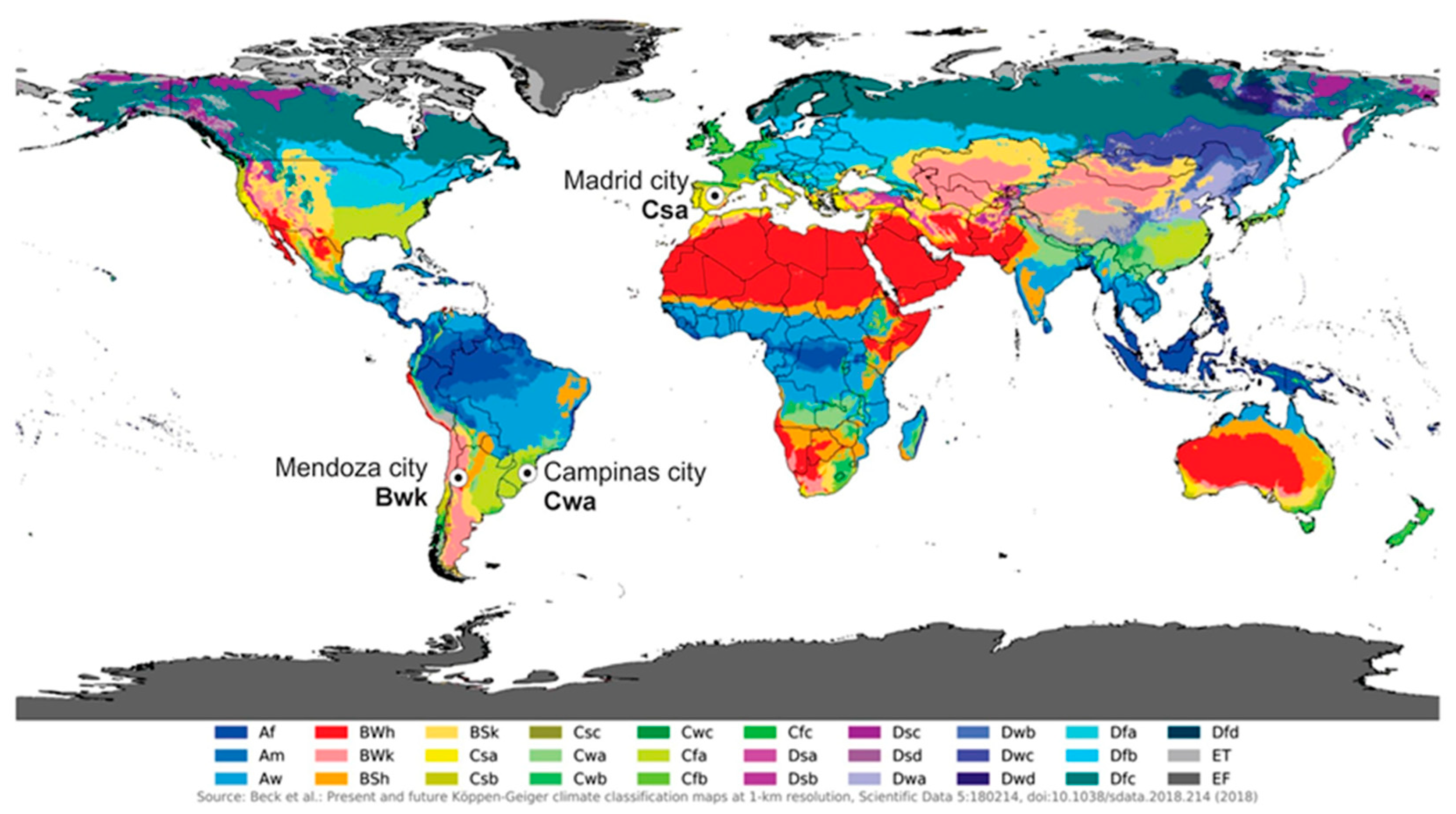





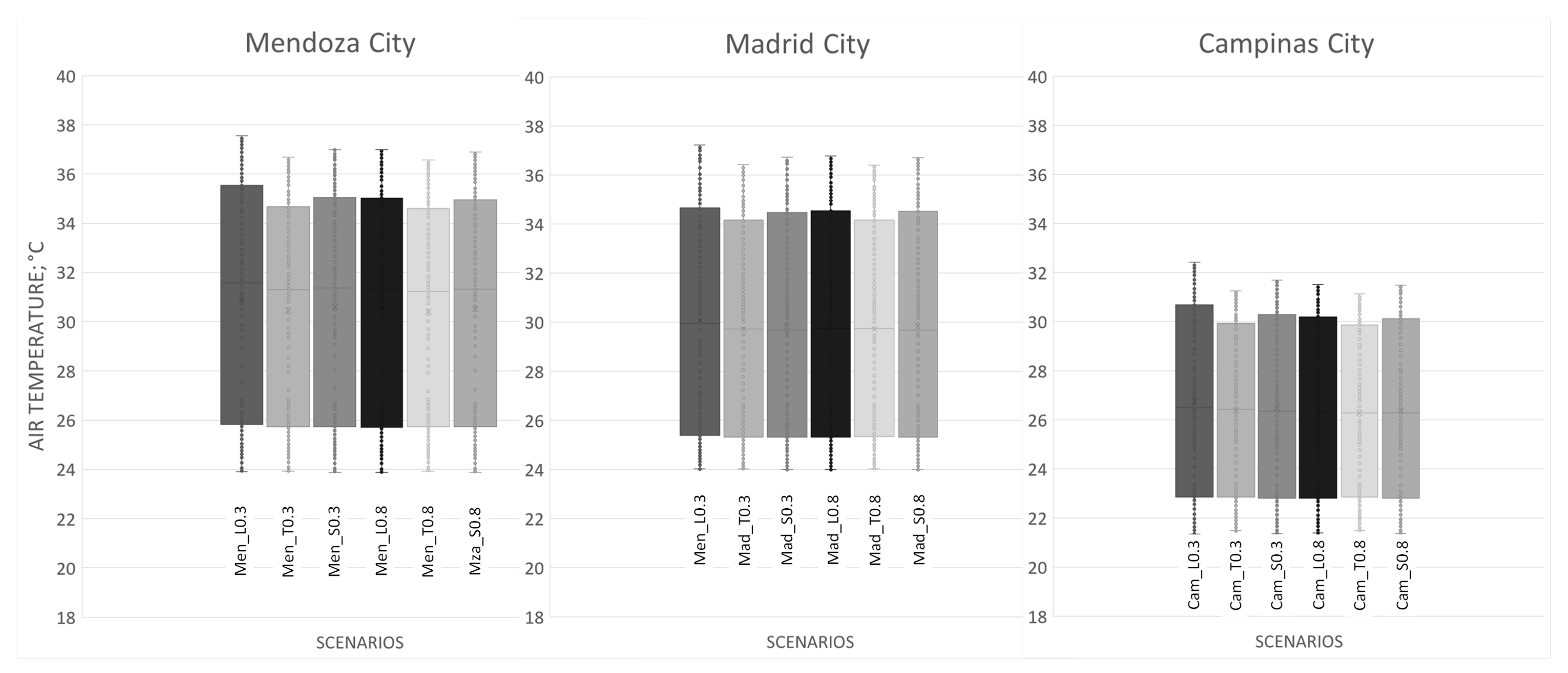



| Characteristics | Mendoza, Argentina | Madrid, Spain | Campinas, Brazil |
|---|---|---|---|
| Location | 32.86° S; 68.86° W 750 m a.s.l. | 40.42° N; −3.70° E 680 m a.s.l. | 22.53° S, 47.04° W 680 m a.s.l. |
| Population | 2,043,540 hab. | 3,460,491 hab. | 1,139,047 hab. |
| Climate according to Köppen classification [27]. | Desert with cold steppe, BWk | Typical Mediterranean, Csa | Warm temperate with dry winters and hot summers, Cwa |
| Maximum daily horizontal global radiation | 1117 W/m2 | 1011 W/m2 | 1020 W/m2 |
| Mean wind speed (height: 10 m) | 2.18 m/s (south) | 2.61 m/s (south) | 2.2 m/s (southeast) |
| Annual mean temperature | 16.79 °C | 14.72 °C | 22.5 °C |
| Average minimum temperatures | −5 °C | −7.6 °C | 12.4 °C |
| Average maximum temperatures | 39 °C | 40.4 °C | 32.5 °C |
| Annual average relative humidity | 60.32% | 52.16% | 69.0% |
| Annual average accumulated precipitation | 220 mm | 435 mm | 1510 mm |
| Parameters | Mendoza (February) | Madrid (August) | Campinas (February) |
|---|---|---|---|
| Average air temperature; °C | 30.7 | 29.8 | 25.9 |
| Maximum air temperature; °C | 40.1 | 38.8 | 31.4 |
| Minimum air temperature; °C | 22.9 | 23.0 | 20.2 |
| Thermal amplitude; °C | 17.2 | 15.8 | 11.2 |
| Average relative humidity; % | 29.0 | 32.3 | 79.0 |
| Average wind speed; m/seg | 5.0 | 3.6 | 1.7 |
| Maximum global solar radiation; W/m2 | 1017 | 1011 | 941 |
| City | ID | Technology | ||
|---|---|---|---|---|
| Lightweight (L) | Traditional (T) | ETIC System (S) | ||
| Mendoza | Low Albedo | Men_L0.3 | Men_T0.3 | Men_S0.3 |
| High Albedo | Men_L0.8 | Men_T0.8 | Men_S0.8 | |
| Madrid | Low Albedo | Mad_L0.3 | Mad_T0.3 | Mad_S0.3 |
| High Albedo | Mad_L0.8 | Mad_T0.8 | Mad_S0.8 | |
| Campinas | Low Albedo | Cam_L0.3 | Cam_T0.3 | Cam_S0.3 |
| High Albedo | Cam_L0.8 | Cam_T0.8 | Cam_S0.8 | |
| Traditional Technology (T)—Thickness: 0.18 m | |||
| Properties | Stucco ext. | Solid Brick | Stucco Int. |
| * Thickness (e); meters | 0.02 | 0.14 | 0.02 |
| * Specific Heat (c); J/kgK | 669 | 650 | 669 |
| * Thermal Conductivity; W/mK | 0.09 | 0.44 | 0.09 |
| * Density (ρ); Kg/m3 | 1920 | 1500 | 1920 |
| Albedo | 0.30/0.80 | 0.30/0.80 | |
| * Emissivity | 0.90 | 0.90 | 0.90 |
| Thermal Transmittance of the Component | 1.07 W/m2K | ||
| Lightweight Technology (L)—Thickness: 0.12 m | |||
| Properties | Cementitious board ext. | Isolant EPS | Cementitious board int. |
| * Thickness (e); meters | 0.015 | 0.09 | 0.015 |
| * Specific Heat (c); J/kgK | 840 | 1500 | 840 |
| * Thermal Conductivity; W/mK | 0.2 | 0.07 | 0.2 |
| * Density (ρ); Kg/m3 | 620 | 400 | 620 |
| Albedo | 0.3/0.8 | 0.3/0.8 | |
| * Emissivity | 0.94 | 0.94 | |
| Thermal Transmittance of the Component | 0.623 W/m2K | ||
| Exterior Thermal Insulation System (S)—Thickness: 0.21 m | |||
| Properties | Cementitious board ext. | Isolant EPS | Solid Brick int. |
| * Thickness (e); meters | 0.015 | 0.05 | 0.14 |
| * Specific Heat (c); J/kgK | 840 | 1500 | 650 |
| * Thermal Conductivity; W/mK | 0.2 | 0.07 | 0.44 |
| * Density (ρ); Kg/m3 | 620 | 400 | 1500 |
| Albedo | 0.3/0.8 | 0.3/0.8 | |
| * Emissivity | 0.94 | 0.9 | |
| Thermal Transmittance of the Component | 0.782 W/m2K | ||
| Technology | Layer | e; m | ρ; kg/m3 | c; J/kg·K | Ci; J/m2·K |
|---|---|---|---|---|---|
| Traditional (T) | Exterior Stucco | 0.02 | 1920 | 669 | 25,670 |
| Solid Brick | 0.14 | 1500 | 650 | 136,500 | |
| Interior Stucco | 0.02 | 1920 | 669 | 25,670 | |
| Ctotal | 0.18 | 187,840 | |||
| Lightweight (L) | Exterior Cementitious Board | 0.015 | 620 | 840 | 7812 |
| EPS Insulation | 0.09 | 400 | 1500 | 54,000 | |
| Interior Cementitious Board | 0.015 | 620 | 840 | 7812 | |
| Ctotal | 0.12 | 69,624 | |||
| Exterior Thermal Insulation Systems (S) | Exterior Cementitious Board | 0.015 | 620 | 840 | 7812 |
| EPS Insulation | 0.05 | 400 | 1500 | 30,000 | |
| Interior Solid Brick | 0.14 | 1500 | 650 | 136,500 | |
| Ctotal | 0.21 | 174,312 |
| Scenarios | AT; °C | MRT; °C | |||||
|---|---|---|---|---|---|---|---|
| Average | Maximum | Minimum | Average | Maximum | Minimum | ||
| Mendoza | Men_L0.3 | 30.9 | 37.57 | 23.89 | 34.14 | 69.33 | 20.33 |
| Men_T0.3 | 30.46 | 36.68 | 23.92 | 32.15 | 64.87 | 20.15 | |
| Men_S0.3 | 30.58 | 36.99 | 23.89 | 32.81 | 66.29 | 20.28 | |
| Men_L0.8 | 30.57 | 37 | 23.87 | 35.32 | 72.18 | 20.2 | |
| Men_T0.8 | 30.41 | 36.57 | 23.93 | 34.69 | 70.96 | 20.21 | |
| Men_S0.8 | 30.53 | 36.89 | 23.89 | 35.18 | 71.97 | 20.28 | |
| Madrid | Mad_L0.3 | 30.06 | 37.22 | 24.01 | 33.15 | 69.51 | 20.9 |
| Mad_T0.3 | 29.72 | 36.41 | 24.02 | 31.65 | 64.98 | 20.31 | |
| Mad_S0.3 | 29.83 | 36.71 | 23.99 | 32.15 | 67.05 | 20.45 | |
| Mad_L0.8 | 29.85 | 36.77 | 23.99 | 34.51 | 72.76 | 20.26 | |
| Mad_T0.8 | 29.72 | 36.41 | 24.03 | 34.02 | 70.31 | 20.33 | |
| Mad_S0.8 | 29.83 | 36.71 | 23.99 | 34.38 | 72.61 | 20.45 | |
| Campinas | Cam_L0.3 | 26.76 | 32.43 | 21.35 | 31.99 | 65.72 | 18.22 |
| Cam_T0.3 | 26.38 | 31.23 | 21.48 | 30.12 | 62.33 | 18.36 | |
| Cam_S0.3 | 26.48 | 31.7 | 21.37 | 30.98 | 62.87 | 18.28 | |
| Cam_L0.8 | 26.42 | 31.51 | 21.38 | 33.21 | 69.34 | 18.29 | |
| Cam_T0.8 | 26.29 | 31.12 | 21.49 | 32.38 | 68.83 | 18.38 | |
| Cam_S0.8 | 26.38 | 31.49 | 21.37 | 33.06 | 69.18 | 18.28 | |
| Color scale: | |||||||
 | |||||||
 | Mendoza–Argentina |  | Madrid–Spain |  | Campinas–Brazil |
|---|---|---|---|---|---|
Men_T0.3 | 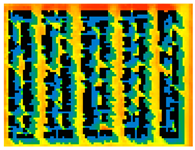 | Mad_T0.3 |  | Camp_T0.3 | 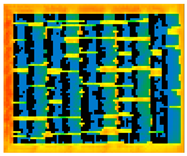 |
Men_T0.8 |  | Mad_T0.8 |  | Camp_T0.3 |  |
Men_L0.3 |  | Mad_L0.3 |  | Camp_L0.3 | 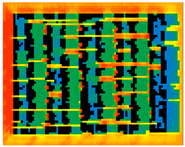 |
Men_L0.8 | 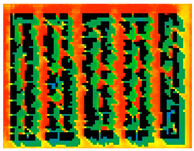 | Mad_L0.8 |  | Camp_L0.8 |  |
Men_S0.3 | 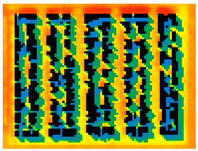 | Mad_S0.3 | 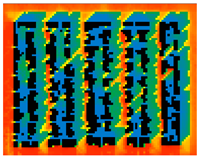 | Camp_S0.3 | 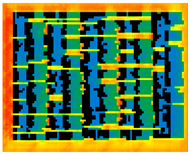 |
Men_S0.8 | 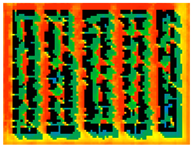 | Mad_S0.8 |  | Camp_S0.8 | 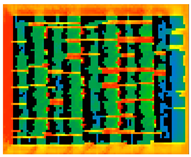 |
Disclaimer/Publisher’s Note: The statements, opinions and data contained in all publications are solely those of the individual author(s) and contributor(s) and not of MDPI and/or the editor(s). MDPI and/or the editor(s) disclaim responsibility for any injury to people or property resulting from any ideas, methods, instructions or products referred to in the content. |
© 2025 by the authors. Licensee MDPI, Basel, Switzerland. This article is an open access article distributed under the terms and conditions of the Creative Commons Attribution (CC BY) license (https://creativecommons.org/licenses/by/4.0/).
Share and Cite
Alchapar, N.; Giancola, E.; Pérez, G.; Terraza, M.; Pezzuto, C. Façade Strategies for Climate Resilience: The Impact of Thermal Mass and Albedo on Urban Microclimates Across Different Climatic Zones. Urban Sci. 2025, 9, 428. https://doi.org/10.3390/urbansci9100428
Alchapar N, Giancola E, Pérez G, Terraza M, Pezzuto C. Façade Strategies for Climate Resilience: The Impact of Thermal Mass and Albedo on Urban Microclimates Across Different Climatic Zones. Urban Science. 2025; 9(10):428. https://doi.org/10.3390/urbansci9100428
Chicago/Turabian StyleAlchapar, Noelia, Emanuela Giancola, Gloria Pérez, Maira Terraza, and Cláudia Pezzuto. 2025. "Façade Strategies for Climate Resilience: The Impact of Thermal Mass and Albedo on Urban Microclimates Across Different Climatic Zones" Urban Science 9, no. 10: 428. https://doi.org/10.3390/urbansci9100428
APA StyleAlchapar, N., Giancola, E., Pérez, G., Terraza, M., & Pezzuto, C. (2025). Façade Strategies for Climate Resilience: The Impact of Thermal Mass and Albedo on Urban Microclimates Across Different Climatic Zones. Urban Science, 9(10), 428. https://doi.org/10.3390/urbansci9100428














